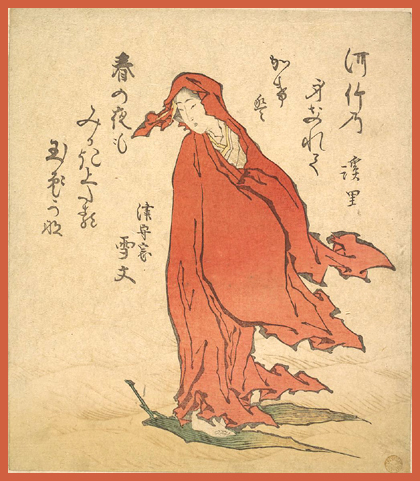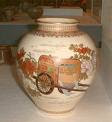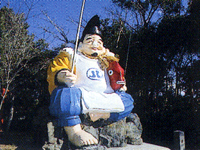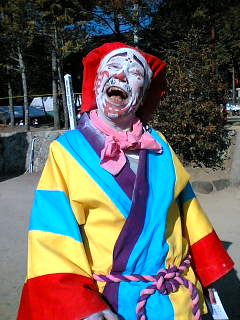[ . BACK to Worldkigo TOP . ]
:::::::::::::::::::::::::::::::::::::::::::::::::::::::::::::::::::::::::::::::::::::::::::::::::::::
Daruma and the Courtesans,
Onna Daruma, Oiran and Daruma
芸者,花魁とだるま、女だるま
Daruma as a lady, Daruma with the ladies...
- source : Tokyo Metropolitan Museum -
Iwabuchi Onna-Daruma, Daruma as a Courtesan
... ... ... 岩淵の女達磨
Utagawa Kunisada (1786-1864)
The background showing a landscape between stations Kanbara and Yoshiwara on the Tôkaidô road, from the series Tôkaidô comparing popular figures with stations of the Tôkaidô (Tookaidoo).
Curtesy to Asian Art. Look at more of their phantastic prints.
http://www.asianartschmitz.de/englisch/holzschnitte.html
:::::::::::::::::::::::::::::::::::::::::::::::::::::::::::::::::::::::::::::::::::::::::::::::::::::
Oiran (花魁, Oiran)
were high-class courtesans in Japan. The word "oiran" consists of two kanji, 花 meaning "flower", and 魁 meaning "leader" or "first." Cultural aspects of oiran traditions continue to be preserved to this day.
The oiran arose in the Edo period, 1600 - 1868. At this time, laws were passed restricting brothels to walled districts set some distance from the city center. In the major cities these were the Shimabara in Kyoto, the Shimmachi in Osaka, and in Edo, the
Yoshiwara. These rapidly grew into large, self-contained "Pleasure Quarters" offering all manner of entertainments. Within, a courtesan's birth rank held no distinction but there arose a strict hierarchy according to beauty, character, educational attainments and artistic skills.
Among the oiran, the tayū (太夫 or 大夫, tayū) was considered the highest rank of courtesan or prostitute, and were considered suitable for the daimyo. Only the wealthiest and highest ranking could hope to patronise them.
© More in the WIKIPEDIA !
. nanshoku、danshoku 男色 homosexuality in Edo .
:::::::::::::::::::::::::::::::::::::::::::::::::::::::::::::::::::::::::::::::::::::::::::::::::::::
ONNA DARUMA女達磨 was a popular theme.
Onna Daruma also comes as a Netsuke.

For the little secret under her skirt, see here:
http://www2s.biglobe.ne.jp/~musasi01/netuke/203/daru.htm
http://www.flickr.com/photos/gabigreve2000/640985313/
.......................................................................
We also have the story of a courtesan who commented about Daruma
"Well, he was sitting in quiet meditation for nine years, but we here have to sit and suffer in the Noisy Pleasure Quarters for more than ten years!"
The painter Hanabusa Itchoo made a picture of the curtesan, which became the model of the Princess Daruma Dolls.
. Hanabusa Itchoo, Itchō 英一蝶 Hanabusa Itcho . (1652 – 1724)
With a Daruma Painting.
:::::::::::::::::::::::::::::::::::::::::::::::::::::::::::::::::::::::::::::::::::::::::::::::::::::
Read about the courtesans in the Yoshiwara quarters of Old Edo and their connection with our Daruma.
Another courtesan that Bunkoo speaks about is
Rizen. Sold to the Oomiya brothel by her husband, a pharmacist by the name of Kuwanaya Yasoo, Rizen "had a kind heart, was deeply compassionate, and professed a strong faith in Boddhisatva Samantabhadra (Fugen bosatsu)." Bunkoo presents her as being more devout than most of the Buddhist monks.He reminds his listeners, who may have been shocked at his associating a prostitute with a boddhisatva, that Samantabhadra, while riding a white elephant, had actually revealed himself to his devotees in the form of a prostitute.
Bunkoo also spoke aboutr a Buddhist monk of the Heian period, Shookuu (910-1007), who taught that "if one wants to worship Samantabhadra, he should go to Harima to see the singing and dancing of the courtesans." Bunkoo's conjunction of boddhisatvas and courtesans was meant to shock his listeners and also to satirically expose hypocritical Buddhist monks.
In his strong defense and praise of Rizen, Bunkoo argues that
"Daruma Buddha faced the wall sitting in meditation for nine years. But the courtesan Rizen spent not nine, but ten years confined to her place of business, facing the wall, season after season all day long."
Bunkoo admitted that his inspiration for this insight had come from Hanabusa Itchoo. The artist had employed the same type of contrast in his paintings. He once painted the face of a courtesan on the body of the Daruma.
This painting of a female Daruma, holding a fan and tobacco pouch and dressed like a courtesan, was a visual expression of the incongruity and contrast of which Bunkoo was so fond. On Hanabusa's painting were written the words:
"What is nine years of suffering
compared with ten years of prostitution?"
Read this great story about
Violating Censorship: Humor and Virulence in the Popular Writings of Baba Bunkoo (1715-1759)
William J. Farge Loyola University, New Orleans
http://web.aall.ufl.edu/SJS/Bunko.html
Safety Copy of this article
http://groups.yahoo.com/group/DarumaArchives-002/message/41
- - - - -
. tamagouri, tamago uri 玉子売り / 卵売り vendor of eggs .
selling boiled eggs around Yoshiwara
:::::::::::::::::::::::::::::::::::::::::::::::::::::::::::::::::::::::::::::::::::::::::::::::::::::
Civilized Daruma by Tsukioka Yoshitoshi
 http://www.davidrumsey.com/amico/amico9102234-73351.html
http://www.davidrumsey.com/amico/amico9102234-73351.html
:::::::::::::::::::::::::::::::::::::::::::::::::::::::::::::::::::::::::::::::::::::::::::::::::::::
Daruma/Kannon by Seki Yuho (1900-1982)
The two pillars of Buddhism are insight—symbolized by the Grand Patriarch Daruma-and compassion—represented by the Goddess Kannon.
The mark of a true Zen master is to be able
to identify with both the masculine and feminine aspects of Buddha-nature, and indeed such great teachers as Hakuin, Sengai, and Tesshu were able to paint Daruma and Kannon equally well. In this painting we have both Zen teachers together, a real treat.
About the Artist
Seki Yuho was born in Fukuoka. He became abbot of the major Zen temple Eigenji in 1956, and frequently traveled overseas to give instruction in Zen. Yuho wrote a number of books, including one entitled
Die Once, and You Won't Die Again. He was a proflic Zen artist, both calligraphy and painting.
http://www.shambhala.com/zenart/html/gallery/detail/d31.cfm
:::::::::::::::::::::::::::::::::::::::::::::::::::::::::::::::::::::::::::::::::::::::::::::::::::::
Kitagawa Utamaro (1754-1806)
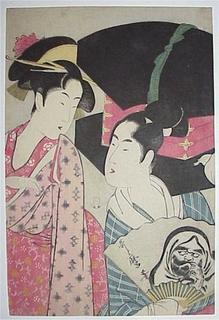
A seller of fan-papers ( jigami-uri ) and a young beauty from an untitled series of eight prints published c1797 by Tsuruya Kiemon. The idealised itinerant merchant has black fan-shaped lacquer boxes perched on his shoulder. In his hand he holds a fan with an image of Daruma eyeing the couple.
http://www.ukiyo-e.demon.co.uk/beauties.htm
Look at this detail of the Daruma enjoying himself
(from Farland Collection)
 . jigami uri 地紙売り in Edo .
. jigami uri 地紙売り in Edo .
jigami uri 地紙売り kagema boys selling paper for fans and talking about kabuki
:::::::::::::::::::::::::::::::::::::::::::::::::::::::::::::::::::::::::::::::::::::::::::::::::::::
Let us read a paragraph from DARUMA
by Neill McFarland.
A common theme is the pairing of Daruma with a woman. Typically in the woodblock prints, the woman is identified as a courtesan. Young, beautiful and gorgeously attired, she is demure,but also emotionless - perhaps, one could say,as calm and self-sufficient as a Zen monk. Daruma, on the other hand, traditionally so stolid, here is the epitome of discomfiture. His gargling eyes, otherwise symbols of outward alertness and inner awareness, now bug at th eunaccustomed distraction and attraction of the female presence.
His whole demeanor suggests rather incriminatingly that, for all his vaunted self-discipline, this most austere personage must content with a residue of human passion.
Daruma is also present with courtesans not as a second principal figure, but as a secondary detail in the total composition - a picture on the wall, a decoration on a garment, a tumbler doll, on a fan ...
During the Edo period, the frustration of living under repressive conditions pushed frivolous tendencies to the level of social satire, and it also contributed to an obsessive interest in amourous liaisons with the enchanting denizens of the pleasure quaters. It is not surprising, that Daruma, seemingly so in control, became an object of parody and ribaldry. Given his ubiquity and the stereotyped character of his presentations, he was an obvious canditate.
H. Neill MacFarland
Daruma:
The founder of zen in Japanese art and popular culture
I take this chance to express my thanks to Farland Sensei for this wonderful book, which has been my stepping stone to my real and now virtual Daruma Museum.
Most of the following illustrations are from the Book of Farland Sensei.
- Books about Daruma
:::::::::::::::::::::::::::::::::::::::::::::::::::::::::::::::::::::::::::::::::::::::::::::::::::::
Picture of Daruma and Geisha
by Fuji no Yuki Kaikei Soga
富士雪会稽曽我(ふじのゆきかいけいそが)

演劇博物館所蔵 Tsubouchi Memorial Theater Museum
http://www.waseda.jp/enpaku/gallery/bunchou/1_04.html
:::::::::::::::::::::::::::::::::::::::::::::::::::::::::::::::::::::::::::::::::::::::::::::::::::::
Okumura Masanobu 1686 - 1764 奥村正信
Reclining somewhat apprehensively on a huge leaf, Daruma is propelled across the water by a courtesan and a kabuki actor famous for female roles.
Ink Sketch. Farland Collection.
http://wwar.com/masters/o/okumura_masanobu.html
http://www.oberlin.edu/allenart/collection/masanobu_okumura.html
:::::::::::::::::::::::::::::::::::::::::::::::::::::::::::::::::::::::::::::::::::::::::::::::::::::
Suzuki Harunobu 1743 - 1807 鈴木晴信

In an uncharacteristic display of vanity, Daruma gazes at his reflection in the water and daintly tweezes some stray hairs from his beard,while the young woman poles the boat.
Ink Sketch. Farland Collection
Look at a colored version of this hanga HERE !
:::::::::::::::::::::::::::::::::::::::::::::::::::::::::::::::::::::::::::::::::::::::::::::::::::::
 Giving Daruma a smoke.
Giving Daruma a smoke.
Present only as a painting on a hanging scroll in the tokonoma, Daruma is stirred to life by a courtesan. As he leans toward her, she turns and offers him her pipe.
Ink Sketch. Farland Collection
http://wwar.com/masters/s/suzuki_harunobu.html
Daruma with a courtesan. Unknown artist. 17th century.

Ink Sketch. Farland Collection.
 - Shared by Kenza Saadi Elmandjra -
Joys of Japan, Facebook, August 2012
- Shared by Kenza Saadi Elmandjra -
Joys of Japan, Facebook, August 2012
.......................................................................

達磨と美人図 -
Courtesan plucking Daruma's beard
Bairinsai, Setsuzan, fl. 19th c - 梅林斎雪山
- source : content.cdlib.org/ark -
:::::::::::::::::::::::::::::::::::::::::::::::::::::::::::::::::::::::::::::::::::::::::::::::::::::
Takeda Harunobu 竹田春信
 Daruma in drag.
Daruma in drag.
Satire and commedy reach their peak in the exchange of clothes between Daruma and a courtesan.
Farland Collection.
..........................................................................
Kawanabe Gyoosai (1831 - 89) 河鍋暁斎
Kawanabe Kyosai
 House of pleasure.
House of pleasure.
Though not a woodblock print, this painting belongs to the genre of ukiyo-e parodies. As the subject of a mural, Daruma is an embrrassed but curiously attentive guest at a wild party in the pleasure quaters.
 Farland Collection
... //www2.ocn.ne.jp/
More about Kawanabe Kyosai
In the Daruma Museum
Daruma with Lady, Kawanabe Kyosai
Kawanabe Kyosai
Farland Collection
... //www2.ocn.ne.jp/
More about Kawanabe Kyosai
In the Daruma Museum
Daruma with Lady, Kawanabe Kyosai
Kawanabe Kyosai (Kawanabe Gyoosai, Kyoosai) 河鍋暁斎.
Painter, (1831-1889)

:::::::::::::::::::::::::::::::::::::::::::::::::::::::::::::::::::::::::::::::::::::::::::::::::::::
Here he is enjoying himself with the ladies in Kutani Pottery
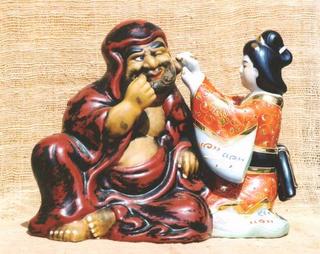
More about this in my story of
Kutaniyaki and Daruma
:::::::::::::::::::::::::::::::::::::::::::::::::::::::::::::::::::::::::::::::::::::::::::::::::::
Things found on the Way
Nice Gallery of Hanga with Folk Art Themes, one of them a Lady Daruma Doll
http://www.showa-corp.jp/toshakan/gallery/ita/ita07.html
〔1〕 三春の木馬(福島県)
http://www.showa-corp.jp/toshakan/gallery/ita/ita01.html
〔2〕 花巻の鶏(岩手県) Chicken from Iwate
〔3〕 加茂の猫(新潟県) Cat from Niigata
〔4〕 富山の獅子頭(富山県) Lion Heads from Fukuyama
〔5〕 古賀の子守り(長崎県) Children from Nagasaki
〔6〕 三条の鳩持ち(新潟県) Dove from Niigata
〔7〕 竹田の女達磨(大分県) Lady Daruma from Oita

〔8〕 鳥取のきびから姉さま(鳥取県) Tottori
http://www.showa-corp.jp/toshakan/gallery/ita/ita01.html
:::::::::::::::::::::::::::::::::::::::::::::::::::::::::::::::::::::::::::::::::::::::::::::::::::::
Ishikawa Toyonobu (1711–85)
Courtesan Dancing to Daruma’s Accompaniment

Among the most popular subjects in mitate-e are pairings of courtesans with religious figures such as
Daruma (Bodhidharma in Chinese), the Indian monk who transmitted Chan (Zen in Japanese) Buddhism to China, as seen at the top of this post. The juxtaposition of this ascetic with a courtesan of the pleasure quarters humorously critiqued religion as well as the culture of the ruling samurai class who boasted of their dedication to Zen. It also underscores the core values of the genre known as ukiyo-e (or ‘pictures of the floating world’), to which this painting belongs. The word ukiyo (‘transitory world’) was derived from Buddhism, referring to the ephemeral nature of this world. By replacing the character for uki 憂き (meaning ‘transitory’) with a homonym 浮meaning ‘floating,’ a profound Buddhist idea was turned upside down to express the attitude of joie de vivre characteristic of the pleasure quarters.
Zen Buddhism teaches that anyone is able to reach enlightenment through simple, banal activities such as chopping wood or taking naps. Here, the courtesan’s knowledge of the ‘floating world’ (ukiyo 浮世) is compared to Daruma’s enlightened realization of the ‘evanescence of the world’ (ukiyo 憂き世). It also suggests that one can find enlightenment, or release, in the carnal activities of the pleasure quarters. Pious Daruma playing the shamisen, a popular musical instrument among courtesans and geisha, further increases the wry humor.
The poem accompanying the image is by Old Priest Rinsen in the Jōkyō era (1684–88).
It reads:
Why have you come from the west?
Don’t ask and cause me to regret it.
In playing the shamisen, the bridges do not count.
The heart alone sings:
Is it the plectrum or the strings
Which makes the music?
Tr. Kuniko Brown
source : pacificasiamuseum.wordpress.com
:::::::::::::::::::::::::::::::::::::::::::::::::::::::::::::::::::::::::::::::::::::::::::::::::::::
Nighthawks, yotaka 夜鷹
The cheapest prostitutes, on small boats by the rivers and walking the streets with a straw mat, were called
"nighthawks (night hawks)" yotaka or streetwalkers (sooka).
The word "yotaka" refers usually to these girls, not to the bird.
Since the Showa period, nighthawk is used for 宵っ張り yoitsupari, a night owl or a
night person.
"yotaka soba 夜鷹蕎麦" means a
buckwheat stall for midnight customers.
. Edo Yatai 江戸屋台 Food stalls in Edo .
The most famous three ones were for
Sushi, Tenpura and Soba buckwheat noodles.
Oumayagashi by Hiroshige
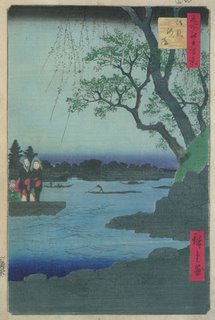
It is a murky winter night as the Oumayagashi ferry approaches its landing on the west bank of the Sumida just north of the Asakusa rice granaries of the bakufu. Against this somber background, the white faces, red sashes and blue head-towels of the two women in the bow of the ferry stand out in bright relief.
These are yotaka, "night hawks," the lowest class of street prostitutes. They are accompanied by their gyu, perhaps a father or brother, who served as bodyguard and tout. This scene is the closest Hiroshige ever gets to depicting the harsh realities of lower-class life in Edo, and he does so in a way calculated not to offend.
© Robyn Buntin of Honolulu
:::::::::::::::::::::::::::::::::::::::::::::::::::::::::::::::::::::::::::::::::::::::::::::::::::::
yuujo 遊女 "woman to play with", cheap prostitutes
- - - - - Yosa Buson - - - - -
ほととぎす歌よむ遊女聞ゆなる
hototogisu uta yomu yuujo kikoyu naru
hototogisu
I hear a curtesan
composing poetry
Tr. Crowley
..........................................................................
Buson had spent some time in Sanuki, Shikoku in 1766 and on the way back visited the famous port town of
Murotsu, Muro no Tsu 室津 in Harima no Kuni, now Hyogo prefecture.
The town was famous for its prostitutes on boats.
 source and more photos : kamnavi.jp/log/ugayuujo.htm
梅咲て帯買室の遊女かな
source and more photos : kamnavi.jp/log/ugayuujo.htm
梅咲て帯買室の遊女かな
ume saite obi kau muro no yuujo kana
plums are blossoming
and the prostitutes of Muro
buy new sashes . . .
Tr. Gabi Greve
朝霜や室の揚屋の納豆汁
asagiri ya muro no ageya no natto jiru
morning mist -
the Natto soup at the brothel
of Muro
Tr. Gabi Greve

Murotsu Kaido 室津街道 the
Murotsu Road
source : murotsukaidou
ageya 揚屋 House of assignation, where patrons made appointments with courtesans in the pleasure quarters, precursor of the geisha teahouse.
MORE vocabulary about the Geisha world:
source : www.eurekaencyclopedia.com
..........................................................................
若竹や橋本の遊女ありやなしや
wakatake ya hashimoto no yuujo ariya nashi
 source : ameblo.jp/poire-w-pere/entry
source : ameblo.jp/poire-w-pere/entry
Buson -
Wakatake ”若竹図”
At Kyoto Kawasaki there was a place famous for bamboo called HASHIMOTO, and many boats passed the river Yodogawa, where famous courtesans waited for customers on the left bank ..
But the HASHIMOTO of Buson might not be there, rather coming from a Noh theater play 江口のはしもと
Eguchi no Hashimoto.
Buson might have been wondering if even nowadays famous geisha would be there near the Hachiman shrine of Hashimoto.
Even the famous monk Saigyo had been visiting this place and wrote waka poems about it.
Wakatake bamboo might also have reminded Buson of his own mother.
- quote -
Eguchi (江口) is a Noh play of the third category, written by Zeami around a fragment (the harlot's sermon) by Kanami. The play combines two legends, one related of the holy man Shōkū (concerning the identity of the harlot of Mura with the bodhisattva Fugen) and the other related of the monk Saigyō (the admonishment of the harlot of Eguchi).
A travelling monk arrives by night at the port of Eguchi. Seeing a cairn, he enquires about its origin and is told that it commemorates the Lady of Eguchi, a former harlot who was considered to be a manifestation of the bodhisattva Fugen. (During a rainstorm, the 12th-century monk Saigyō asked for shelter at her house, but was refused entry. He reproached her with an impromptu poem, to which she made an effective reply, hinging on a Buddhist interpretation of the words "a moment's refuge"; she then admitted him and engaged in a long conversation.)
The travelling monk thoughtfully recites Saigyō's poem to himself, and is overheard by a passing woman, who asks him to follow it with the harlot's reply. She tells the monk not to believe the gossip about her; when she vanishes they realise that she is, in fact, the ghost of the harlot of Eguchi.
A villager then tells them the story of Shōkū, who longed to worship the living Fugen, and was directed in a dream to seek the Lady of Eguchi.
Fascinated, the monk begins to repeat a sutra by her grave. A boat, brightly moonlit, appears, bearing the Lady along with two singing girls. They sing of the unhappiness of mortals ensnared in illusion and condemned to be reborn. In conclusion, they remind the monk that "all things are a moment's refuge"; the Lady reveals her identity as Fugen, and ascends into the clouds.
© More in the WIKIPEDIA !
young bamboo -
will the courtesans still be there
at Hashimoto ?
Tr. Gabi Greve
- Chris Drake wrote:
Eguchi is on the west bank of the Yodo River just north of Osaka and far downstream from Hashimoto, which is on the east bank of the river not far south of Kyoto. Buson elsewhere mentions the 'courtesans in Eguchi and Hashimoto,' i.e., the courtesans at two spots where there used to be elegant women singers and dancers who sometimes also took male customers. Buson is referring to Eguchi no Kimi, who appears in the noh play 'Eguchi' as well as to other famous women performers who danced and sang along the Yodo River centuries before. In this hokku, he is praising the beautiful young bamboos in Hashimoto in his day, and deep inside one grove of young bamboos there he sees houses he knows to be the houses where courtesans work. Of course he knows that the Hashimoto courtesans of his day aren't well educated and can't, like the famous Eguchi no Kimi, exchange waka poems with the famous poet-monk Saigyo, or refuse visitors, as Eguchi no Kimi refused Saigyo. He knows that the ancient courtesans in Hashimoto are gone forever, and that the present women in this house are probably just sex workers, but he wonders if there could possibly, as in a dream, be the real, classical women performers of Hashimoto inside the houses. His question is probably rhetorical: of course it is impossible, and yet, and yet.... So the tone seems to be elegiac.
He is half-seeing a vision of ancient houses. The bamboos grow equally beautifully year after year, but the human world is different, and the elegant, educated, artistic performers of Hashimoto (and Eguchi downstream) are gone forever. The bamboos suggest time passing, returning every year and continually fresh and alive as a species, so they are both beautiful and cruel, since time causes humans to die and disappear. The bamboos might also suggest that the modern young women in the houses are not allowed to grow freely and become naturally beautiful like the bamboos because of the poverty that forces them to be sex workers.
Buson has a nice haiga of this hokku that shows several thin bamboos standing in front of two or possibly three houses.
(see above Wakatake)
The last line of the hokku refers to a waka by Narihira in the 9th episode of 'Ise Tales' (Ise-monogatari).
There the protagonist, exiled to the east, sees a bird on the Sumida River and asks the bird whether the woman he loves who lives back in the capital (and whose clandestine love for him seems to be the reason for his exile) is still alive or not. Buson, however, uses only one 'ya.' This allusion suggests Buson is asking whether the famous women performers of Hashimoto are still alive or not. Unfortunately the answer is surely -- except in the time of visions and noh plays -- no....) Buson may see himself as a modern Narihira or Saigyo, and he seems to wish a visionary woman would appear from out of the distant past -- or the other world. The bamboos are a moving border between this world and the other.
- source : Chris Drake , facebook 2017 -
. Buson travelling the river Yodogawa 淀川 - Fushimi .
- - - - -
. Fugen Bosatsu 普賢菩薩 Samantabhadra .
河内女の宿に居ぬ日やきじの声
Kawachi-me no yado ni inu hi ya kiji no koe
the Kawachi weaver girls
are not at home -
voice of the pheasants
Tr. Gabi Greve
Kawachime refers to the girls who had to weave cotton, since the Kawachi-plain 河内平野 (now Osaka plain) was famous for cotton plants.
the "voice of a pheasant" ould be a man calling for his girl . . .
. WKD : Cotton from Kawachi .
..........................................................................
抱籠やひと夜ふしみのさゝめごと
dakikago ya hitoyo fushimi no sasamegoto
Sleep with "daki kago"!
As with a one-night harlot at Fushimi
Exchanging lovers' talks.
- Comment by Shoji Kumano
. "hug basket" dakikago 抱籠 .
kigo for all summer
. Yosa Buson 与謝蕪村 in Edo .
sasamegoto ささめごと promises and secrets exchanged by lovers
- and
“Murmured Conversations”
Muromachi-period (1333−1568) poetic treatise on renga (linked verse) written by the Tendai monk Shinkei.
春雨や同車の君がさざめ言
. harusame ya doosha no kimi ga sasamegoto .
or
yuku haru ya doosha no kimi no sasame goto
:::::::::::::::::::::::::::::::::::::::::::::::::::::::::::::::::::::::::::::::::::::::::::::::::::::
keisei, 傾城, another expression for a lady of the night.
And some HAIKU
tama-arare yotaka wa tsuki ni kaerumeri
hailstones –
in moonlight, the nighthawks
come home
Uejima Onitsura (1660-1738)
(Tr. Michael Haldane)
かはほりに夜ほちもそろりそろり哉
kawahori ni yahochi mo sorori-sorori kana
like the bats
the nighthawk too
slow and sure
Kobayashi Issa
(Tr. David Lanoue)
:::::::::::::::::::::::::::::::::::::::::::::::::::::::::::::::::::::::::::::::::::::::::::::::::::::::

Utagawa Kuniyoshi
igned: Ichiyūsai Kuniyoshi ga 一勇斎国芳画
"Zazenmame" from the series
Daruma's buffonery (Doke Daruma Asobi)
Actors caricatured as Daruma (rare).
After the imposition of a ban on actor prints in 1842, Kuniyoshi produced numerous humorous designs with thinly disguised actors’ portraits. In this series, well known actors are portrayed as Daruma, without any mention of their names. This series is listed as number 191 in Kuniyoshi by Basil William Robinson (Victoria and Albert Museum, London, 1961).
According to the Kuniyoshi Project this publisher is Hori Masa. There are other prints in this series which carry a different publisher's seal.
Marks says that this publisher's seal only appeared in 1849.
Actors Ichimura Uzaemon XII (right), Ichikawa Danjūrō VIII (center) and Onoe Kikujirō II (left)
- source : woodblockprints.org
. Utagawa Kuniyoshi 歌川国芳 .
:::::::::::::::::::::::::::::::::::::::::::::::::::::::::::::::::::::::::::::::::::::::::::::::::::::::
More ONNA DARUMA in my photo album
Scroll: Daruma with Lady
"Onna Daruma" by Toba Hiromaru 鳥羽広丸
"Onna Daruma" by Yamahigashi Kyooden 山東京伝
. senryu about Yoshiwara 吉原 pleasure quarters in Edo .
. Yoshiwara Nana Fushigi 吉原七不思議
The Seven Wonders of Yoshiwara .
. - - - Welcome to Edo 江戸 ! .
:::::::::::::::::::::::::::::::::::::::::::::::::::::::::::::::::::::::::::::::::::::::::::::::::::::
[ . BACK to DARUMA MUSEUM TOP . ]
[ . BACK to WORLDKIGO . TOP . ]
- #onnadaruma #courtesandaruma #femaledaruma -
:::::::::::::::::::::::::::::::::::::::::::::::::::::::::::::::::::::::::::::::::::::::::::::::::::::







